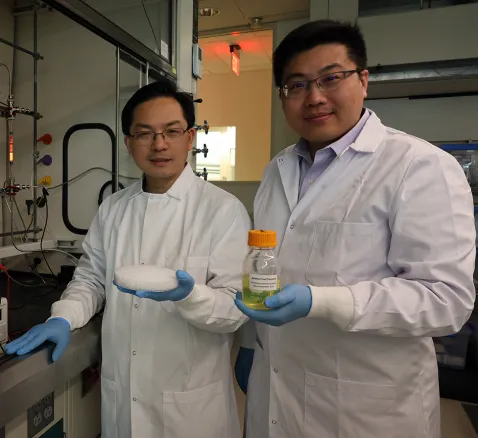Making fuels from sunlight
The ocean serves as Earth's largest dynamic carbon sink, absorbing 400 million tons of carbon dioxide (CO₂) annually through continuous exchange with the atmosphere. Researchers at Yale have now developed an efficient system to extract and convert dissolved CO₂ into clean fuels and useful industrial feedstock. Published in Nature Communications, this breakthrough could transform seawater into a sustainable source for carbon-based products while helping balance oceanic CO₂ levels.
Professor Shu Hu from the department of chemical and environmental engineering and a member of Yale Energy Sciences Institute, led the project and describes the system as a “solar-driven, ocean-based carbon capture and conversion.” Or, more simply, it’s making “fuels from sunlight.” The team uses sunlight to transform seawater’s dissolved carbon into syngas—a synthesis gas comprising carbon monoxide (CO) and hydrogen. This versatile compound serves as a key building block for producing valuable industrial chemicals and fuels.

“It works like a perfectly synchronized relay race.
Xiang Shi
Co-author of study
Previous efforts to harness solar energy for converting seawater's dissolved carbon into useful products have faced significant challenges. The extremely low concentration of carbonate ions in seawater makes it difficult to achieve both high energy efficiency and selective product formation. Moreover, existing reactors are limited to lab-scale experiments. In addition to catalysts, a reactor design capable of continuous, large-scale operation is needed to truly utilize carbon dioxide from seawater.
Based on the Hu group's expertise in designing photocatalysis and the reactor that maximize the use of light for chemical transformation, they developed a new photoelectrochemical device. It uses only sunlight to turn dissolved carbon in seawater—mainly bicarbonate—into syngas. The process mimics how photosynthesis works in ocean ecosystems and reaches a solar-to-fuel efficiency of 0.71%, which is similar to how well seaweed converts carbon. Even more striking is the team’s discovery that, despite the close-to-zero concentration of carbonate in seawater, the selectivity of the reaction can be dramatically influenced by the flow field within the reactor. In static seawater, the CO content in the product was just 3%. However, under the controlled flow conditions inside the reactor, the CO proportion surged to 21%.
“It works like a perfectly synchronized relay race,” explained Xiang Shi, the study's co-author and a graduate student in Hu's lab. “The anode passes protons and CO₂ to the cathode, which then sprints toward the finish line—conversion. This teamwork drives the entire reaction to completion efficiently. We achieved this by designing the reactor so that the flow first sweeps through the anodes, where water is oxidized and protons are released. These protons are carried by the flow, triggering a cascade of reactions along the way that convert bicarbonate into dissolved CO₂, which is then transported to the cathodes downstream and reduced.”
Through this approach, they engineered the mass transfer process of the reaction, regulating the flux reaching the electrode surface. In this way, they not only managed to remove carbon dioxide from seawater, but also used sunlight to generate fuel directly from the ocean.
Next, the researchers plan to hone the system’s technology, and ultimately to upscale it into a large-scale industry-level reactor. The modular reactor design enables these flow cells to be assembled into square-meter scale floating arrays. These buoyant reactors harness natural tidal movements and ocean currents to passively circulate seawater through the system. As seawater flows across the reactors, they continuously convert dissolved CO₂ into syngas under sunlight, which can be collected and transported to industrial facilities for downstream utilization in chemical synthesis or fuel production.
“We hope to build the large-scale floating reactors on the sea so we can directly use the sunlight and the seawater to produce solar fuels,” Hu said.
More Details
Published Date
Jul 7, 2025


